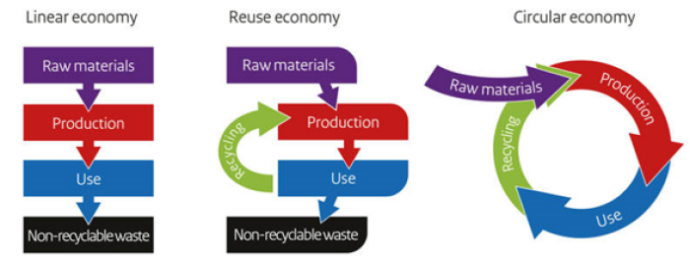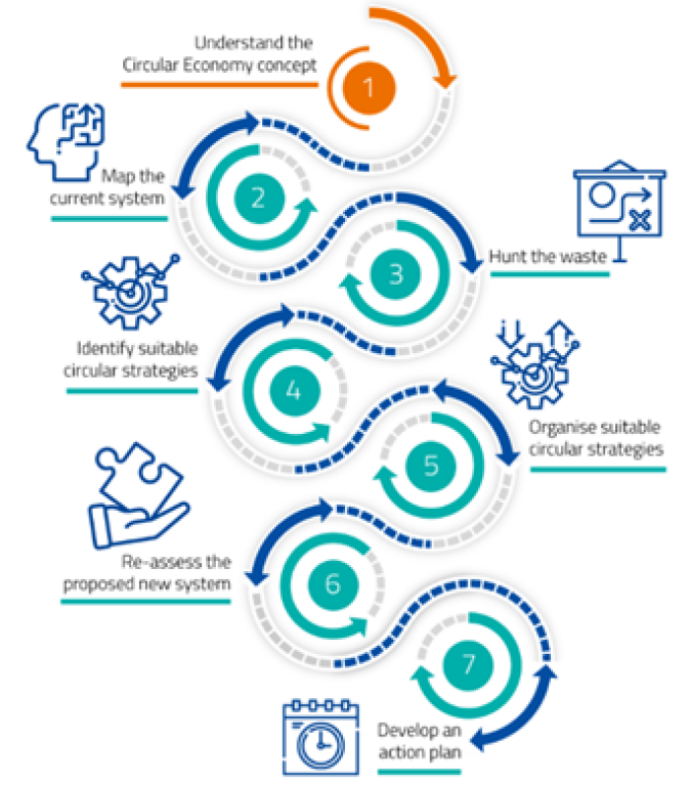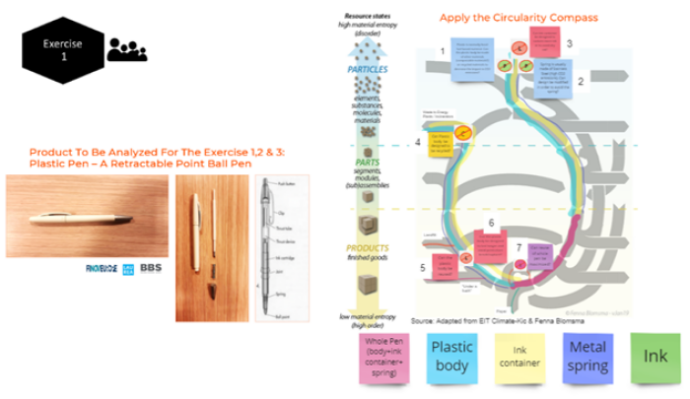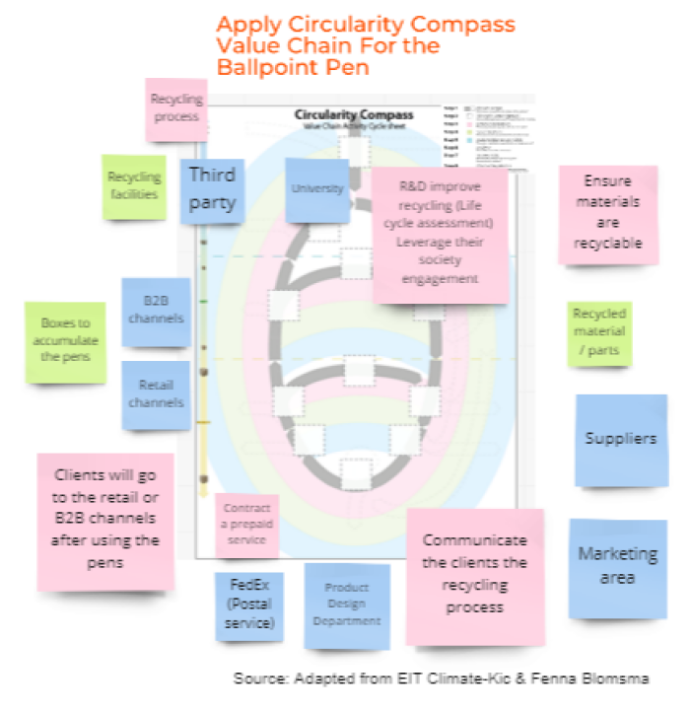This article aims to introduce circularity thinking approach and give a first understanding of the key tools of the circularity thinking toolkit provided by EIT Climate-Kic and designed by Professor Fenna Blomsma.
 Photo by Jason Goodman on Unsplash
Photo by Jason Goodman on Unsplash
The article describes how to move from theory to practice by applying the tools on a real case study. Empirical research data was collected from two online workshops in October 2022 with Waste Management and Circular Economy Master students at Bologna Business School in Italy. These workshops were run by the three coaches together: Eleonora Foschi, Bologna Business School, Tiziana Pagano, Finoveurope Ltd and Kati Tawast, Laurea University of Applied Sciences.
The feedback and teamwork results of the executed workshops gave some idea of the strengths and weaknesses of the Circularity Thinking tools. The workshops showed how a group of business managers adopted the approach for establishing a structured journey towards circular economy transition.
Circular Economy and Systems Innovation Mindset
Circular economy (CE) can be regarded as an umbrella concept around the goals of improved resource productivity and value creation, and reduced value loss and destruction (Blomsma & Fennan 2017).
The transition to a circular economy involves a shift from “take, make and waste” to a system that uses as few new raw materials as possible. The basic idea behind the transition is shown in the Figure 1 below. In the figure, the three economic models are identified, each of which has a different starting point with respect to its approach to the use of raw materials: the linear economy, the reuse economy and the circular economy. (Netherlands Government 2016).
 Figure 1: From a Linear to a Circular Economy. (Netherlands Government 2016)
Figure 1: From a Linear to a Circular Economy. (Netherlands Government 2016)
In a linear economy (Figure 1), raw materials are extracted from the earth, used and discarded: “take-make-waste”. At best, this economy leads to the relative decoupling of economic growth from the use of natural resources. In the reuse economy (Figure 1), many non-recyclable materials are used again (cascading, repair/maintenance, reuse, remanufacturing, recycling). At best, this reuse economy leads in part to an absolute decoupling of economic growth from the use of natural resources and from emissions: the demand for natural resources and the emissions decrease as the economy grows. The ideal picture is a circular economy (Figure 1) in which raw materials are never depleted. This economy can be structured so that there is a positive coupling between economic growth and the growth of natural resources (“negative” emissions / positive footprints). In a circular economy, value chains will be organised differently. (Netherlands Government 2016).
Circularity Thinking – an approach and toolkit for systems design for circular economy is described in Figure 2. This approach is provided by EIT Climate-Kic and designed by Professor Fenna Blomsma.
 Figure 2: Circularity Thinking- An approach for Systems Design for Circular Economy (EIT Climate-Kic 2021)
Figure 2: Circularity Thinking- An approach for Systems Design for Circular Economy (EIT Climate-Kic 2021)
Circularity Thinking approach starts from the analysis of the current situation. What is the problem/missed opportunity with the current use of resources and products? One tries to map the current flow of the materials and products along the value chain of the system. By doing this one gets better understanding how resources flow in the current system and how they could flow differently. The better current resource flows are mapped, the more precisely one can identify: Problems/pain points, e.g. which materials cause environmental issues, are scarce causing price volatility or face regulatory changes for waste disposal. One can also more precisely identify: Opportunities/missed benefits of, e.g. cost savings or expanding into new markets. Addressing these problems or identifying these benefits is one starting point of applying circular strategies.
Content & process design
Circularity Thinking approach and tools designed by Professor Fenna Blomsma were applied in the form of two workshops given to the Waste Management and Circular Economy Master students at Bologna Business School in Italy. The group consisted of 31 business managers.The focus of the workshops was to move from theory to practice by applying the tools on a real case study given by the coaches of the workshops.
During the workshops the following tools were presented:
- Circularity Compass
- 5 Big Structural Wastes Framework
- Value Chain Activity Cycle
After presentation of the Circularity Thinking Approach and tools, company case examples were shared and working teams were formed to apply the tools on real case study (ball point pen) given by coaches (Figure 3).
 Figure 3: How to develop Circular Economy Strategies: your step by step guide (Source: EIT Climate-Kic 2021)
Figure 3: How to develop Circular Economy Strategies: your step by step guide (Source: EIT Climate-Kic 2021)
The planning of the workshops was started already in Spring 2022 and the content was co-created by having several Teams meetings between the three coaches. Before the final presentation deck was ready it took 26 iteration rounds.
Circularity Thinking approach & tools workshops took place on October 11th & 13th, 2022, as Teams meetings. The students were given as pre reading the three articles before the actual workshops.
In these 3,5 -hour long workshops focus was on applying the tools on a real case study. The team exercises were done in Miro whiteboard using the prepared canvases supplied by the coaches. Each team worked in their own Teams call while doing the exercises and the coaches were circulating between the Teams calls and giving the tutoring for each team. The deliverables of the exercises were shared to the whole group which enabled the learning from the peers as well.
In figure 4 one can see some of the teamwork deliverables when applying the Circularity Compass and 5 Big Structural Wastes tool on the Miro board.
 Figure 4: Teamwork deliverables when applying the Circularity Compass and 5 Big Structural Wastes tool (Source: Circularity Thinking workshop teamwork deliverables on the Miro Board 2022)
Figure 4: Teamwork deliverables when applying the Circularity Compass and 5 Big Structural Wastes tool (Source: Circularity Thinking workshop teamwork deliverables on the Miro Board 2022)
In figure 5 one can see some of the teamwork deliverables when applying the Circularity Compass Value Chain Activity Cycle tool on the Miro board.
 Figure 5: Teamwork deliverables when applying the Circularity Compass Value Chain Activity Cycle (Source: Circularity Thinking workshop teamwork deliverables on the Miro Board 2022)
Figure 5: Teamwork deliverables when applying the Circularity Compass Value Chain Activity Cycle (Source: Circularity Thinking workshop teamwork deliverables on the Miro Board 2022)
Conclusions
The written and oral feedback as well as teamwork results of the executed workshops gave some idea of the strengths and weaknesses of the Circularity Thinking tools. The Circularity Thinking workshops showed how a group of business managers adopted the approach for establishing a structured journey towards a circular economy transition.
The workshop participants were business managers with the work experience and studying Waste Management and Circular Economy Master’s degree at Bologna Business School. One can assume that this background helped them in adopting the Circularity Thinking approach and using the toolkit. Owing to the overall timetable of the Waste Management and Circular Economy course the two workshops were hold during the same week. This required quite an intensive working from the students when preparing their homework and team presentations between the two workshops. We coaches felt that there was a positive feeling and good energy when teams applied the tools. Participants found the circularity thinking toolkit useful as it provides a number of tools to lead the conversations relevant to circular economy and systems thinking.
References:
- Blomsma, F. & Brennan, G.2017. The emergence of circular economy- a new framing around prolonging resource productivity. J Ind. Ecol.
- EIT Climate-Kic 2021, Innovation through Circular Economy – Train-the-Trainer course
- Foschi, E., Pagano, T. & Tawast, K. 2022. Circularity Thinking approach & Toolkit workshop presentation hold for Bologna Business School Master students in Teams.
- Netherlands Government 2016. A Circular Economy in the Netherlands by 2050 Government-wide Programme for a Circular Economy. Referred 9.11.2022. https://circulareconomy.europa.eu/platform/sites/default/files/17037circulaireeconomie_en.pdf